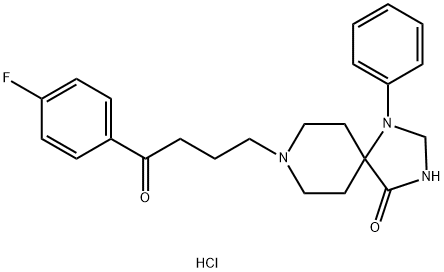2022-29-9
 2022-29-9 結(jié)構(gòu)式
2022-29-9 結(jié)構(gòu)式
常見(jiàn)問(wèn)題列表
|
D 2 Receptor 0.06 nM (Ki) |
D 1 Receptor ~350 nM (Ki) |
D 3 Receptor 0.6 nM (Ki) |
D 4 Receptor 0.08 nM (Ki) |
D 5 Receptor ~3500 nM (Ki) |
5-HT 2A Receptor 1 nM (Ki) |
5-HT 1A Receptor 49 nM (Ki) |
α1B-adrenoceptor
|
Calcium-activated chloride channel
|
Spiperone is a potent intracellular Ca
2+
enhancer (EC
50
=9.3 μM) and stimulates intracellular Ca
2+
through a protein tyrosine kinase-coupled phospholipase C-dependent pathway, which results in increased secretion of Cl
-
in Calu-3 and CFBE41o
-
cell monolayers.
Spiperone significantly decreases the production of nitric oxide in lipopolysaccharide-stimulated BV-2 microglia cells, primary microglia and primary astrocyte cultures. Spiperone also significantly inhibits nitric oxide production in ATP-stimulated primary microglia cultures. Spiperone markedly decreases the production of TNF-α in BV-2 microglia cells. Spiperone attenuates the expression of inducible nitric oxide synthase and proinflammatory cytokines such as IL-1β and TNF-α at mRNA levels in BV-2 microglia cells.
Spiperone (1.5 mg/kg; intraperitoneal injection; on days 1, 3, 6, 7, and 13-21; C57Bl/6 mice) treatment reduces infiltration of the alveolar interstitium and alveolar ducts with inflammatory cells and prevents the growth of the connective tissue in the parenchyma of Bleomycin lungs.
| Animal Model: | C57Bl/6 mice (7-8-week-old) induced pulmonary fibrosis by Bleomycin |
| Dosage: | 1.5 mg/kg |
| Administration: | Intraperitoneal injection; on days 1, 3, 6, 7, and 13-21 |
| Result: | Reduced infiltration of the alveolar interstitium and alveolar ducts with inflammatory cells and prevented the growth of the connective tissue in the parenchyma of bleomycin lungs. |